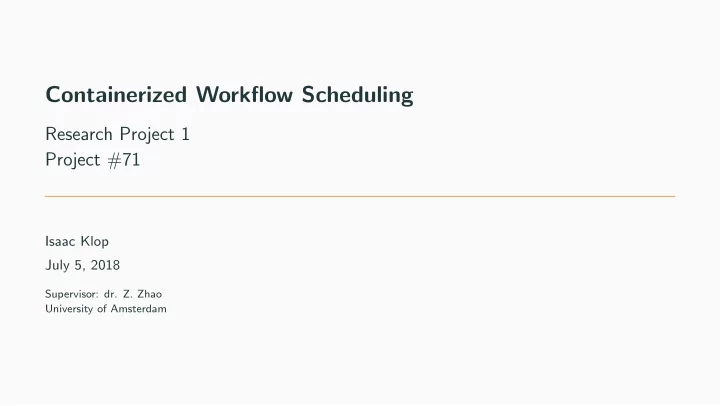

Containerized Workflow Scheduling Research Project 1 Project #71 Isaac Klop July 5, 2018 Supervisor: dr. Z. Zhao University of Amsterdam
Introduction - Workflows • Nodes represent tasks • Edges represent dependencies Figure 1: Example workflow 1
Introduction - Workflow Management Systems • Used to manage/execute workflows • Automation • Failure recovery • Map tasks to resources • Examples: • Pegasus [1] • Taverna [2] 2
Introduction - Tasks as Containers • OS-level Virtualization • Lightweight • Stand-alone Figure 2: Example of binaries packaged with their dependencies in a container [3] 3
Introduction - Container Orchestration • Containers at scale • Cluster of multiple nodes • Automates scheduling, deployment and management of containers • Examples: • Docker Swarm [4] • Kubernetes [5] Figure 3: Example of a cluster with 3 worker nodes. 4
Problem statement - Combining Workflows and Container Scheduling • Find node for container • Queue is FIFO • Context of task is lost • No dependencies • Ordering/Dependencies on higher level 5
Research Question How can we order the execution of a containerized workflow on a container scheduler? 6
Related Work • Argo - Container-native workflow engine for Kubernetes [6] • Apache Airflow - Plugin for Kubernetes (in development) [7] • Makeflow on Mesos by Zheng et al. [8] 7
Method 1. Design a workflow with a critical path 2. Run workflow on container schedulers • Two container scheduling algorithms: Docker Swarm and Kubernetes • Two workflow scheduling algorithms: Critical path and Batch 3. Measure total execution time 8
Method - The Workflow 9
Method • Infinite resources: 5+20+90+5=120 seconds • Constrained resources: • Swarm: 5 nodes x 1 GB RAM • Kubernetes: 4 nodes x 1 GB RAM • Assuming no overhead: • Depending on the ordering of tasks Table 1: Lowest/Highest possible total execution times assuming no overhead Scheduler Lowest Highest Swarm 120s 160s Kubernetes 130s 180s 10
Method - Order the Execution • Submit containers in order • Scheduler queue is not FIFO • Seemingly random • Kubernetes: • Priority flag • Swarm: • No priority flag • Hold back part of tasks 11
Results - Swarm Figure 5: Average execution time of the Workflow on Swarm 12
Results - Kubernetes Figure 6: Average execution time of the Workflow on Kubernetes 13
Conclusion • Scheduling queue is not FIFO • Execution time is erratic • Critical path slightly lower execution times 14
Discussion • Container schedulers lack features • Kubernetes priority flag does pre-emption • Interface between Workflow Management System and Container Scheduler • Monitoring • Active re-ordering • More scheduling algorithms 15
Questions? Questions? 16
References i E. Deelman, K. Vahi, G. Juve, M. Rynge, S. Callaghan, P. J. Maechling, R. Mayani, W. Chen, R. F. da Silva, M. Livny et al. , “Pegasus, a workflow management system for science automation,” Future Generation Computer Systems , vol. 46, pp. 17–35, 2015. K. Wolstencroft, R. Haines, D. Fellows, A. Williams, D. Withers, S. Owen, S. Soiland-Reyes, I. Dunlop, A. Nenadic, P. Fisher et al. , “The taverna workflow suite: designing and executing workflows of web services on the desktop, web or in the cloud,” Nucleic acids research , vol. 41, no. W1, pp. W557–W561, 2013. Docker, “What is a Container?” https://www.docker.com/what-container, Accessed 01-07-2018. “Docker Swarm,” https://docs.docker.com/engine/swarm/, Accessed 01-07-2018. “Kubernetes,” https://kubernetes.io/, Accessed 01-07-2018. 17
References ii “Argo - GitHub,” https://github.com/argoproj/argo, Accessed 01-07-2018. “Apache Airflow (incubating) website,” https://airflow.apache.org/, Accessed 01-07-2018. C. Zheng, B. Tovar, and D. Thain, “Deploying high throughput scientific workflows on container schedulers with makeflow and mesos,” in Proceedings of the 17th IEEE/ACM International Symposium on Cluster, Cloud and Grid Computing . IEEE Press, 2017, pp. 130–139. 18
Recommend
More recommend